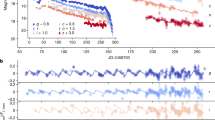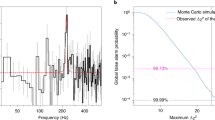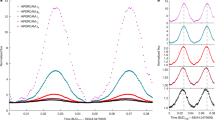Abstract
THE X-ray transient source GS2023 + 338 was discovered in out-burst by the Ginga satellite in 1989 (ref. 1) and has since been identified with the previously known recurrent nova V404 Cygni2. This system is recognized to be a low-mass X-ray binary3, with X-ray behaviour similar to black hole systems4, but attempts to deduce an orbital period from photometry5–9 and spectroscopy10,11 have yielded modulations with periods from 10 minutes to 6 hours. Two years after the outburst, we have used the William Herschel Telescope to find absorption features in V404 Cyg characteristic of a late G or early K star with a radial velocity curve of amplitude 211 ± 4km s−1 and period 6.473 ± 0.001 days. The deduced mass function of 6.26±0.31 M⊙ is a firm lower limit to the mass of the compact object, which for reasonable assumptions of orbital inclination and companion star mass must be a black hole with probable mass in the range 8–15.5 M⊙. We consider this the most persuasive case yet for the existence of a black hole.
This is a preview of subscription content, access via your institution
Access options
Subscribe to this journal
Receive 51 print issues and online access
$199.00 per year
only $3.90 per issue
Buy this article
- Purchase on Springer Link
- Instant access to full article PDF
Prices may be subject to local taxes which are calculated during checkout
Similar content being viewed by others
References
Makino, F. et al. IAUC 4782 (1989).
Marsden, B. G. IAUC 4783 (1989).
Charles, P. A. et al. IAUC 4794 (1989).
Tanaka, Y. in Proc. 23rd ESLAB Symp. on Two Topics in X-Ray Astronomy (ed. Hunt, J. & Battrick, B.) 3 (ESA Publications, 1989).
Wagner, R. M. et al. in Proc. North American Workshop on CVs and LMXRBs (ed. Mauche, C.W.) 29 (Cambridge University Press, 1990).
Haswell, C. A. & Shafter, A. W. IAUC 5074 (1990).
Udalsky, A. & Kaluzny, J. Publs astr. Soc. Pacific 103, 198–204 (1991).
Gotthelf, E., Patterson, J. & Stover, R. S. Astrophys. J. 374, 340–343 (1991).
Leibowitz, E. M., Ney, A., Drissen, L., Grandchamps, A. & Moffat, A. F. J. Mon. Not. R. astr. Soc. 250, 385–391 (1991).
Casares, J., Charles, P. A., Jones, D. H. P., Rutten, R. G. M. & Callanan, P. J. Mon. Not. R. astr. Soc. 250, 712–725 (1991).
Casares, J. & Charles, P. A. Mon. Not. R. astr. Soc. (in the press).
McClintock, J. E. in The Physics of Accretion onto Compact Objects (eds Mason, K. O., Watson, M. G. & White, N. E.) 211 (Springer, Berlin, 1986).
McClintock, J. E. & Remillard, R. A. Astrophys. J. 308, 110–122 (1986).
Della Valle, M., Jarvis, B. J. & West, R. M. Nature 353, 50–52 (1991).
Watson, M. G. Mon Not. R. astr. Soc. 176, 19–23p (1976).
Matilsky, T. et al. Astrophys. J. 210, L127–131 (1976).
Horne, K., Wade, R. A. & Szkody, P. Mon. Not. R. astr. Soc. 219, 791–808 (1986).
Echevarria, F. D. et al. Mon. Not. R. astr. Soc. 240, 975–990 (1989).
Roberts, D. H., Lehar, J. & Dreher, J. W. Astr. J. 93, 968–989 (1987).
Bahcall, S., Lynn, B. W. & Selipsky, S. B. Astrophys. J. 362, 251–255 (1990).
Bahcall, J. N. Ann. Rev. Astr. Astrophys. 16, 241–264 (1978).
Nagase, F. Publs astr. Soc. Japan 41, 1–79 (1989).
van Paradijs, J. in Accretion-driven Stellar X-ray Sources (eds Lewin, W. H. G. & van den Heuvel, E. P. J.) 189 (Cambridge University Press 1983).
Cowley, A. P., Crampton, D. & Hutchings, J. B. Astrophys, J. 231, 539–550 (1979).
Paczynski, B. Ann. Rev. Astr. Astrophys. 9, 183–208 (1971).
Allen, C. W. Astrophysical Quantities, 3rd edn (Athlone, London, 1973).
Eggleton, P. P., Bailyn, C. D. & Tout, C. A. Astrophys. J. 345, 489–491 (1989).
Chevalier, C., Ilovaisky, S. A., Motch, C., Pakull, M. & Mouchet, M. Astr. Astrophys. 217, 108–114 (1989).
Garcia, M. R., Bailyn, C. D., Grindlay, J. E. & Molnar, L. A. Astrophys, J. 341, L75–78 (1989).
Bailyn, C. D. & Grindlay, J. E. Astrophys. J. 312, 748–754 (1987).
Beavers, W. I. & Eitter, J. J. Astrophys. J. Suppl. 62, 147–228 (1986).
Author information
Authors and Affiliations
Rights and permissions
About this article
Cite this article
Casares, J., Charles, P. & Naylor, T. A 6.5-day periodicity in the recurrent nova V404 Cygni implying the presence of a black hole. Nature 355, 614–617 (1992). https://doi.org/10.1038/355614a0
Received:
Accepted:
Issue Date:
DOI: https://doi.org/10.1038/355614a0
Comments
By submitting a comment you agree to abide by our Terms and Community Guidelines. If you find something abusive or that does not comply with our terms or guidelines please flag it as inappropriate.



